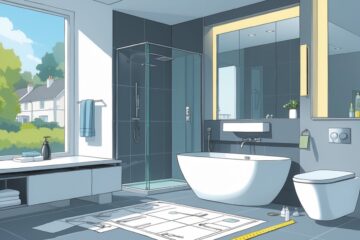Artificial Intelligence is revolutionising many industries, and interior design is no exception. By integrating AI, you can enhance creativity and efficiency in designing spaces that reflect personality and functionality. By utilising AI, you can quickly generate design concepts, manage projects, and transform aesthetics in previously unimagined ways.

AI offers numerous tools and applications designed specifically for interior design, empowering you to explore endless possibilities with precision and ease. Whether you’re creating 3D models or generating furniture layouts, AI-driven platforms streamline your creative process. These tools not only save time but also inspire innovative solutions that align with your style and preferences.
Incorporating AI into your interior design practice also opens up new business opportunities. It allows you to personalise spaces while effectively catering to diverse client needs. AI’s impact on design aesthetics shapes the future by blending the human touch with technological advancements, promising a dynamic evolution in how spaces are conceptualised and executed.
Key Takeaways
- AI enhances creativity and efficiency in designing functional spaces.
- Various AI tools help streamline the design process and inspire solutions.
- AI opens up new business opportunities in the interior design field.
Understanding AI in Interior Design

AI revolutionises interior design by enabling designers to think beyond traditional boundaries and utilise innovative tools that enhance creativity. This transformation is driven by AI tools and the ability to harmonise creative vision with computational power.
The Emergence of AI Tools
AI tools have developed significantly in recent years, offering previously unimaginable capabilities. These tools use complex algorithms to analyse design principles, spatial arrangements, and user preferences. This information is processed to generate personalised interior design solutions.
AI-powered applications offer virtual reality previews, allowing you to visualize changes before they are implemented. They also provide mood boards, suggest decor elements, and estimate costs. Generative AI technology can propose unique design concepts by learning from existing designs, enabling you to find inspiration quickly.
Transforming Creative Vision with AI
AI enhances creative vision by offering new perspectives and possibilities. Generative AI can suggest innovative layouts and design combinations that might not be immediately apparent. This technology helps you experiment with styles, colours, and materials, broadening the scope of creative exploration.
AI-driven design platforms allow you to customise designs based on user behaviour and preferences. These platforms learn from your interactions, adjusting to your unique style and requirements. As a result, AI empowers you to create bespoke interior designs that are both functional and aesthetically pleasing.
Leveraging AI for Project Conceptualisation

Using AI in project conceptualisation can significantly enhance your creative process and streamline material selection. AI offers tools to inspire unique design ideas and ensure cohesive aesthetics in interior design projects.
Inspiring Design Ideas with AI
AI tools can transform how you cultivate design ideas by providing access to various styles and motifs. Algorithms analyse thousands of design elements, offering suggestions and examples that spark creativity. By using these digital inspirations, you can explore different themes and concepts.
AI aids in identifying trends by compiling data from social media, design magazines, and blogs. This helps you stay ahead in the design world and incorporate cutting-edge trends into your work. With AI’s help, you can create a more comprehensive vision that embodies current styles.
By leveraging pattern recognition, AI tools can suggest complementary colours and furniture pieces harmonising with your initial designs. This enhances creativity and speeds up the brainstorming process, allowing you to focus on refining rather than generating ideas from scratch.
Material Selection and Aesthetic Cohesion
AI systems offer sophisticated databases that help you select suitable materials for your projects. These tools assess factors like durability, cost, and environmental impact, enabling informed decisions. AI-driven software often includes virtual libraries where you can compare and choose materials that fit your design ideas.
Aesthetic cohesion is vital in interior design, and AI can ensure all elements in a room complement one another seamlessly. Tools analyse patterns, textures, and colours, providing recommendations that maintain visual balance. This ensures that your final output is both pleasing and functional.
Integrating AI into your material selection process also allows for efficient source tracking. You can monitor suppliers and availability, ensuring your chosen elements make it into the final design and maintaining both quality and aesthetic harmony.
AI Tools and Applications in Interior Design
AI in interior design offers advancements in tools and applications that enhance the design process. From virtual staging to augmented reality, these technologies provide professionals and amateurs with innovative ways to visualise and plan spaces.
Virtual Staging and Room Planners
Virtual staging lets you digitally furnish and decorate a space to help visualise potential layouts. Using AI tools, such as Homestyler and Room Planner, you can experiment with different styles and configurations without moving a piece of furniture. This technology is useful for estate agents and designers to showcase homes realistically. Room planners help you understand space dimensions and layouts.
These design tools also enable you to test various colour schemes and furnishing combinations quickly. Platforms often feature extensive libraries of furniture and decor items, making it easy to find inspiration and see how different elements work together. This practical approach saves time and resources, allowing for cheaper experimentation.
Augmented Reality and 3D Modelling
Augmented reality (AR) bridges the gap between digital planning and real-world application. Tools like IKEA Place and Houzz integrate AR tech to overlay furniture items and design elements into your existing space through smartphone cameras. This allows you to perceive how new additions will coexist with current decor.
3D modelling further enhances this experience by creating lifelike renderings of spaces. These models allow for comprehensive examination from every angle. When coupled with AI, they provide recommendations and adjustments. Understanding potential changes before implementing them helps avoid costly mistakes, ensuring a space that meets your design vision.
Platform and Tool Overviews
Several platforms provide access to advanced AI tools and features tailored explicitly for interior design. Homestyler offers both virtual staging and AR capabilities, giving you a versatile toolset. Room Planner caters to precise layout mapping for hassle-free space arrangement.
IKEA Place and Houzz distinguish themselves with an emphasis on accessible AR. They enable you to see real furniture in your space before purchasing. Each platform brings unique elements to design, allowing you to choose features that best suit your projects. Understanding these tools enables better decision-making and more successful design outcomes.
The Business of AI in Interior Design
Using AI in interior design is transforming business practices. It facilitates professional collaboration and offers various subscription plans catering to different needs. Integrating these tools enhances productivity and cost-effectiveness in the design process.
Collaboration and Professional Use
AI tools for interior design are revolutionising how professionals collaborate. These tools allow designers to work seamlessly across different locations, sharing designs and ideas with clients. Real-time adjustments and virtual walkthroughs become easy, enhancing client satisfaction.
Platforms that integrate with existing software, such as CAD, further improve collaboration. Designers with different expertise can contribute to projects, ensuring diverse input and comprehensive solutions. This fosters a professional environment where creativity coexists with efficiency.
Furthermore, AI tools often incorporate learning from user inputs, tailoring suggestions to fit specific design styles. This personalisation improves the design quality and alignment with client preferences while maintaining professional standards.
Costs and Subscription Plans
Various AI tools offer subscription plans to suit different budget levels. Costs may range from free basic plans to more expensive premium plans with extensive features. These subscriptions are typically structured to meet the specific needs of different users, from individual designers to larger firms.
Paid subscriptions usually offer comprehensive analytics, detailed design libraries, and enhanced rendering capabilities. Many providers also offer flexible billing options, allowing you to choose between monthly or annual payments.
Their efficiency gains often justify the cost of AI tools. Investing in the right subscription can save time and reduce errors, making it a valuable resource in the interior design industry.
Exploring the Impact and Future of AI on Design Aesthetics
Artificial intelligence is redefining design aesthetics by influencing the evolution of design styles and enabling predictions of future trends. Key advancements in machine learning provide designers with tools to create AI images and streamline processes in redesign and remodelling.
The Evolution of Design Styles
AI influences design by expanding the boundaries of creativity. It generates new styles that draw from both historical trends and futuristic concepts. You find that the use of AI images aids in visualising these innovative styles, offering you inspiration and new perspectives.
Machine learning analyses large datasets, identifying emerging style patterns. This enhances one’s understanding of how design preferences evolve. With AI, one can align one’s aesthetics with cultural shifts, seamlessly blending classic and contemporary styles.
Predictive Trends and Remodelling
AI makes trend prediction more accessible. It evaluates geographic, cultural, and social data, helping you anticipate shifts in design preferences. The insights gained enable you to make informed design choices for remodelling projects.
With machine learning algorithms, AI predicts which styles will gain popularity over time. This empowers you to update your designs proactively. By leveraging AI’s analytical capabilities, you enhance the efficiency and effectiveness of your remodelling processes, ensuring you stay ahead in the competitive design landscape.


